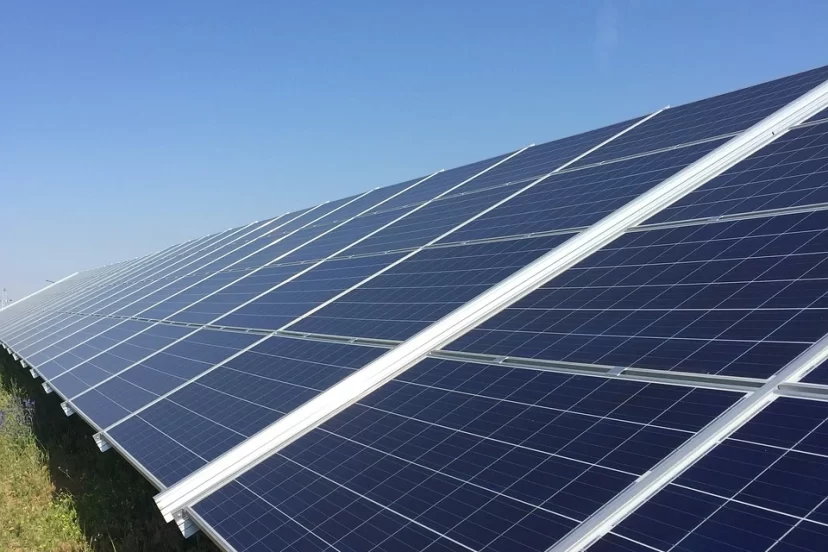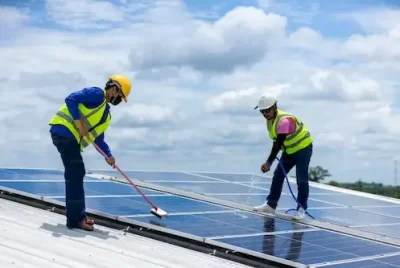Commercial Solar Panel Installation: Step-by-Step Guide
We may earn a commission for purchases made using our links. See our disclosure to learn more.
Solar power has been the fastest-growing renewable solar energy source in the world, with annual growth rates of 22 percent, according to the International Energy Agency. This growth demonstrates the growing acceptance of solar energy as a practical, cost-effective, and ecologically responsible means of satisfying the energy needs of businesses.
The long-term financial benefits of commercial solar panel installation outweigh the initial investment expenditures by a significant margin. A business’s monthly electricity expenditure can be reduced to almost nothing by installing a solar energy system. These cost reductions can eventually more than pay for themselves. Tax credits at the federal level, as well as other incentives at the state and local levels, make solar energy an attractive option for businesses.
Businesses can become energy independent if they generate their own electricity. This safeguards them against the possibility of rising energy bills and makes energy expenditures more predictable.
Adopting solar energy as a power source can help a company look more sustainable. Increased loyalty from existing consumers is possible, as is the acquisition of new ones who share your concern for the environment.
How to Find the Best Solar Energy Company
Level Of Experience
Consider the company’s history and level of experience in the solar industry before hiring them to do the installation. Find a company that knows its way around commercial solar panel installations and has a solid reputation in your sector. This will guarantee that they have a firm grasp of the specific requirements of your company.
Comprehensive Services
The best solar energy company will offer a whole range of services, from first consultation to post-installation maintenance. With this all-inclusive service, you’ll just have to deal with a single provider.
Training and Certifications
Verify if the company has the appropriate accreditations and certifications in your field. These certifications show that the company is committed to high quality and follows industry standards when it comes to solar power.
Customer Reviews and Testimonials
Verify the testimonials and references provided by previous clients. This can help you form a more informed opinion about the company’s dependability, product quality, and dedication to your satisfaction.
Commercial Solar Panel Installation: Step-by-Step Guide
Site Assessment
The first step in capturing clean solar power is to do a thorough site assessment.
● The first, and most important step in getting commercial solar panels is for the provider to send a crew of surveyors and engineers to your business. They begin by taking a look at the site itself, paying special attention to the dimensions, materials, and orientation of the roof. That’s important because it dictates how many and what kind of solar panels can be set up.
● The company’s workers will also assess the site’s suitability for solar energy production. This requires you to calculate the average annual sunlight and average daily sunlight hours for your area. Conditions such as precipitation and the presence of surrounding buildings and trees are also considered. Solar panel efficiency increases with the amount of available sunlight at a given location.
● The company’s workers will also analyze your current energy usage and costs. Your energy bills will be carefully examined so that patterns in energy consumption can be identified. In this way, they may create a system that meets your energy needs at a reasonable cost.
● At last, the company’s workers will identify any problems that could arise throughout the installation process. These may take the form of structural concerns, compliance challenges with local rules, or anything else that stands in the way of a smooth installation. Your company’s unique demands and objectives are carefully considered as we tailor a solar energy solution to meet them.
Design and Engineering
After the site evaluation is over, your solar energy system’s design and engineering can begin. Your chosen solar energy equipment supplier will work with the solar company’s in-house engineering team on this endeavor.
● The site evaluation will determine your company’s energy needs, which will serve as the foundation for the design. Taking into account quality, cost, and efficiency, the team will select the optimal solar panels, inverters, and mounting solutions. They will take your financial constraints and the desired rate of return into account.
● The design will also be affected by the building’s structure. For instance, a ground-mounted system could be considered if the roof isn’t sturdy enough to support the solar panels. The design procedure takes into account the site’s physical limitations as well as the solar system’s technical specifications in order to achieve optimal energy output.
Documentation and Permitting
Once the design phase of a project is over, the next step is the permits and documentation phase.
● Typically, this is handled by the solar installation company, which will also secure any required permits from the relevant authorities. Permits for construction, electricity, and even solar power may be required.
● They also create the necessary paperwork, such as engineering drawings, system specifications, and set-up guides. In order to connect your solar energy system to the electrical grid, your local utility company will require this paperwork to be submitted for approval.
● Having a commercial solar panel installation company manage the permitting procedure can save time and assure compliance with all rules and regulations.
Installation
When all paperwork and permissions are in order, the installation process can begin. There are a few processes involved at this stage, but the first is prepping the site and installing the mounting mechanism for the solar panels. Depending on the layout, this could be on the floor or the roof.
● The solar panels are attached to the mounting system after it has been set up. The panels have been strategically placed to maximize their exposure to sunlight and thus their ability to generate electricity.
● Next, the inverter, a crucial piece of gear that transforms the DC power generated by the solar panels into AC current, must be installed. The inverter is connected to the solar panels by electrical conduits and is often located close to the main panel box.
● At last, everything is connected to your building’s electrical network. To track the energy output of your system, a new meter may be added.
Testing and Commissioning
The solar system is not ready for use until testing and commissioning are performed once the installation is finished.
● It needs to go through extensive testing to make sure everything is working as it should and that the system is generating the desired quantity of power.
● The company responsible for installing your solar panels will perform these checks and make any necessary repairs if problems are found. This may involve performing a visual inspection of the wiring, double-checking the inverter installation, and even putting the system through a complete load test.
● The system gets commissioned when it has been thoroughly tested and any problems have been resolved. Your company can now begin receiving clean, renewable solar energy from the moment the system is fully operational. This final phase marks a significant achievement on the path to energy independence and sustainability for your business.
Maintenance After Installation
Monitoring System
Most solar energy systems have built-in monitoring software that provides real-time data on the system’s output. This makes sure everything is running well and helps find problems early on.
Routine Maintenance
Even while solar panels are built to last and need little in the way of upkeep, they should nevertheless be inspected and cleaned on a regular basis to guarantee they are operating at full efficiency. These are often provided by the business that installs your solar panels.
System Upgrades
Upgrades to the system are something to think about as time goes on and technology advances. These enhancements can be greatly aided by the guidance and assistance of a solar energy equipment supplier with experience in the field.
Emergency Repairs
Solar panels are well-known for their durability and lifespan, but even they can sustain damage and require immediate maintenance. When an unexpected problem arises with your solar panels, having a dependable solar installation firm on call is crucial.
Bottom Line
Changing over to solar power is an investment in your company’s future that will have both financial and environmental rewards. With the appropriate commercial solar panel installation company by your side, what could have been a difficult process may have been a smooth and gratifying experience. By making the change, your business will benefit from the abundant and sustainable solar energy offered by our very own star, the Sun, while also establishing itself as a forward-thinking and ecologically responsible entity.




